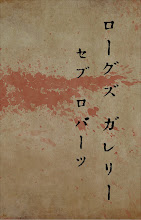 I don't know if it's just the particular idiom that my band finds itself in, but there seems to be an irrational number of math rock bands in Japan. Now, we're not math rock: all of our songs are in 4/4 or 3/4 and there's not any instrumental breaks that could possibly be confused for a Magma homage. But most of the bands we play with are math rock bands - abrupt tempo shifts, asymmetrical time signatures, technically-demanding guitar runs, etc. This is only odd because math rock's heyday in the west came to a close almost a decade ago, as technical puissance was reclaimed by metal-derived genres and indie kids became more concerned with texture & danceability. Why has math rock refused to fade in Japan?
I don't know if it's just the particular idiom that my band finds itself in, but there seems to be an irrational number of math rock bands in Japan. Now, we're not math rock: all of our songs are in 4/4 or 3/4 and there's not any instrumental breaks that could possibly be confused for a Magma homage. But most of the bands we play with are math rock bands - abrupt tempo shifts, asymmetrical time signatures, technically-demanding guitar runs, etc. This is only odd because math rock's heyday in the west came to a close almost a decade ago, as technical puissance was reclaimed by metal-derived genres and indie kids became more concerned with texture & danceability. Why has math rock refused to fade in Japan?There are several things that make math rock particularly appealing to guitar-oriented acts in their early-to-mid twenties. The first is its emphasis on technique; unless the intention is keeping it simple-stoopid, there's a genuine satisfaction in mastery of an instrument. The second is that there was significant crossover between math rock and emo; the semi-hysteric emotional mode of many late-teenagers and college kids is attracted to garment-rending catharsis (especially in a country as emotionally muted as Japan). Finally, when bucking musical convention is as easy as dropping an extra beat into a measure, math rock affords the easy illusion of doing something different - even if the genre's decades-old touchstones have become canonical.
Still, something about Japanese math rock doesn't sit well with me. It's a little too crisp in its execution and too rigorously diatonic. The western push towards deconstruction is being countered by some exacting pull from another source - but what? I couldn't tell from whence came this Will To Order until this weekend, when I noticed something curious on another band's merch table: a toy bank in the shape of a Nintendo Famicon.
 I've a friend who's the kind of geek that hunts down audio rips of old video game music. The past several times I've been over to his apartment, he's had the Mega Man soundtrack bumping in the background. Given the poxy sonic palette of 8-bit FM synthesis, old-school video game composers such as Koji Kondo used every compositional trick available to create dynamic scores: chromatic counterpoint, syncopation, abrupt tempo shifts, asymmetrical time signatures... hey, wait a minute.
I've a friend who's the kind of geek that hunts down audio rips of old video game music. The past several times I've been over to his apartment, he's had the Mega Man soundtrack bumping in the background. Given the poxy sonic palette of 8-bit FM synthesis, old-school video game composers such as Koji Kondo used every compositional trick available to create dynamic scores: chromatic counterpoint, syncopation, abrupt tempo shifts, asymmetrical time signatures... hey, wait a minute.So that's where all these bands picked up their proclivity for epic melodies, Dorian arpeggios, and unnecessary 3-over-2 rhythmic juxtaposition! For every hour spent listening to The Dismemberment Plan, these kids probably spent two sat in front of a video game console. This is the kind of organic synthesis that so many western bands strive for and fail at miserably, coming off instead as so much embarrassing po-mo pastiche. And to think I was dismissing the Japanese bands as stiff, studenty knock-offs of Sunny Day Real Estate - which isn't to say that I like this music any more than I did last week, but at least I'm not baffled by its very existence.
I'll leave you with a couple of concrete examples. Exhibit A is the band we played with in Nagoya on Friday night, the incomprehensibly-named Mudy On The 昨晩.
Exhibit B, the "energy zone" theme from the Nintendo Entertainment System game Contra.
Non-sequitorial postscript: Corporate apologist Eric Harvey takes his "pragmatism" to the big leagues.





No comments:
Post a Comment